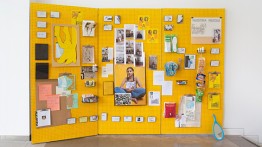You Are Here.
POSTED ON: February 14, 2019
Two 2016 School of Art alumni explore decolonization and placemaking at Queens International 2018, a contemporary art biennial that runs through February 24th at the Queens Museum and select Queens Library branches. “Volumes,” this year’s theme, brings together 43 Queens-connected artists to explore concepts of collecting, accumulating, and distributing information, with many works highlighting the artists’ own connections to local and global communities. This year Emilio Martinez Poppe and KT Pe Benito have works featured in the show. They will be giving a tour of their work on the closing day, February 24.
Martinez Poppe’s installation, “End Credits for the Places That Make Us,” uses computer kiosks located throughout the Queens Museum, prompting visitors to respond to questions about placemaking and memory. As museumgoers exchange dialogue with the computers, a database of participant responses is projected on the gallery walls as an endlessly scrolling list, styled like the credits to a film.
“I have a vested interest in making relationships to place visible,” Martinez Poppe says. “Perhaps this is in part due to the nature of my upbringing across two countries—Peru and the US. Participation and collaboration have always been important to my work.” The “credits” serve as a way to honor the people who collectively produce the work and the places that hold community. “I am interested in demystifying and maintaining dialogue about the ways in which art and knowledge circulate.”
When you enter the museum you will be greeted by KT Pe Benito’s work: a tall, yellow, three-panel pegboard filled with photographs, memorabilia, texts, collage, drawings, and a letter written to the artist’s late grandmother. Entitled "Entries to Faustina (Growing Out of Colonialism for My Grandmother’s Sake)," the work pieces together family history and research into what the artist refers to as the “Filipinx” diaspora.
“I was interested in bringing in a local and personal narrative: an organization of my life, family lineage, and where I come from,” explains Pe Benito, who first started working with the pegboard as a student artist. “When I was making this work at Cooper, I was addressing my nuclear heteronormative interracial family structure. In this iteration at Queens Museum, I prioritize the relationship I hold with my Filipinx non-binary identity and with my late grandmother, Faustina Pascua.” Pe Benito describes the work as an altar to their grandmother’s migration from the Philippines to California.
Queens International 2018 is the first museum showing for the two alumni. The biennial, appropriately situated on the former 1964 World’s Fair ground, was launched in 2002 to showcase the cultural and artistic output of the borough as a hub of diversity, where more than 165 languages and dialects are spoken daily.
The artists cite this larger historical context and interplay between global and local histories as a source of inspiration. “Emilio and I, as collaborators, spent time looking into the history of Queens Museum and the World’s Fair, the community of Queens borough, and the past Queens International biennials. From there we were able to develop our work responding to a history and community that we’re now a part of, the both of us being Queens residents.”
For Martinez Poppe, visits to the Queens Museum and research into its history led to developing “End Credits” in conversation with the setting, in particular the iconic, room-sized panorama of New York City originally built for the 1964 World’s Fair. “The placement of each element of the work also informs the experience. Computer kiosks where you can make an entry surround the panorama and the projection is on the exterior of the enclosing wall. So at some point, you will come into contact with the panorama, whether by choosing to walk through it or walking around it to see the projection.”
Noticeable differences between the skyline of the panorama and the New York City of today point to another central theme of Martinez Poppe’s practice. The artist’s work with Fourth Arts Block, a community arts organization that supports anti-displacement organizing in the Lower East Side, has brought into focus the effects of change in built environments on the cultural fabric of urban communities. The organization has recently partnered with United for Small Business NYC, a campaign to protect small businesses that often serve low-income neighborhoods or are owned by migrants and people of color. “Small businesses play an especially important role for marginalized communities as we face adversity in gathering in public or feel that our culture has institutions which can represent it beyond our lifetimes,” says Martinez Poppe.
Making space for community has also been formative to Pe Benito’s work, dating to their experience finding solidarity with other artists at Cooper. “I co-founded a club within the Joint Activities Committee called Students of Color Crit Club to legitimize and fund the time and effort we would spend outside of our classes to have studio visits dedicated to centering artists of color.”
Pe Benito relates those challenges of addressing stories of racism, colonialism, and migration in the classroom to their artistic practice and activism today. “Though I am seeing more artists of color in the art marketplace and in the New York City scene, there is still a lack of analysis as to how artists of color are included and valued for their contribution in a system that has yet to be restructured at large,” the artist says. “Through this affinity group that developed out of the students of color in the School of Art, I built the strategies, friendships, and networks that I’ll need in order to sustain my practice.”
On Sunday, February 24th, KT Pe Benito and Emilio Martinez Poppe will lead a tour of Queens International 2018: Volumes at the Queens Museum with Assistant Curator Sophia Marisa Lucas. You can register here.







